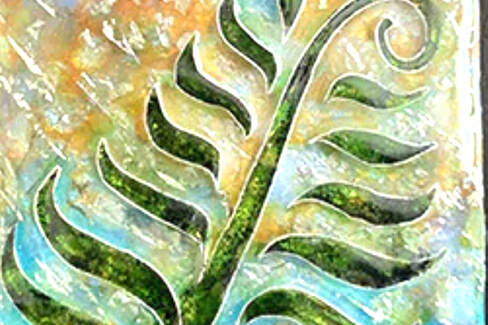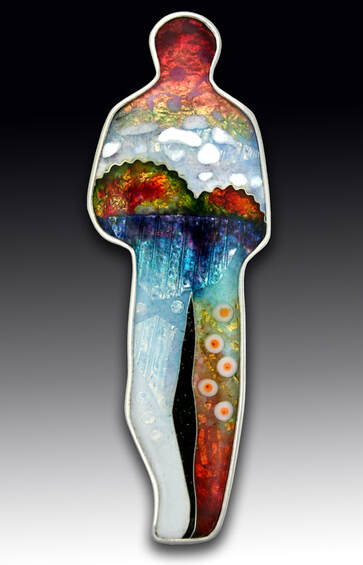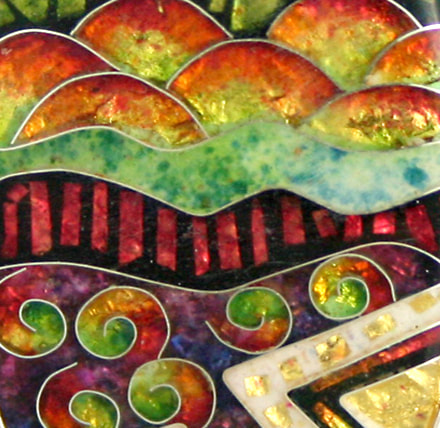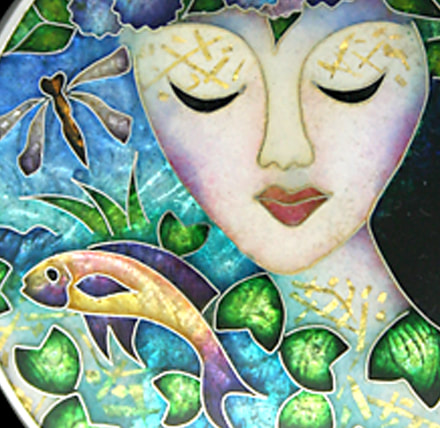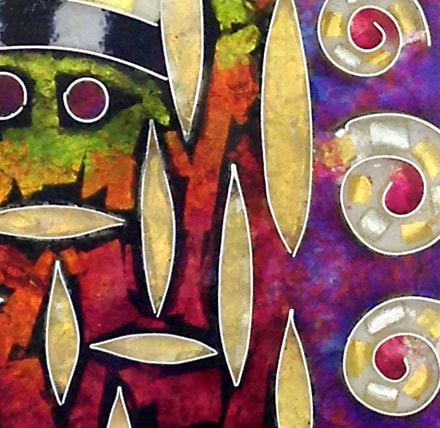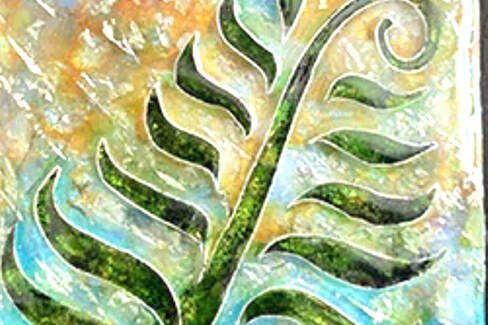Asking "technique" questions gives us "technique" answers.
If we change our questions into "artistic" questions, we begin to explore artistic answers.
The question "Why do I care" is a really important artistic question.
My artistic wife says: "If you don't know why you care, why will anyone else care?"
If I know WHY I care, it's much easier to decide on the WHAT and the HOW
My WHY guides me.
If we change our questions into "artistic" questions, we begin to explore artistic answers.
The question "Why do I care" is a really important artistic question.
My artistic wife says: "If you don't know why you care, why will anyone else care?"
If I know WHY I care, it's much easier to decide on the WHAT and the HOW
My WHY guides me.
As Simon Sinek covers in his book, Start With Why: How Great Leaders Inspire Action, knowing your "why" is critically important in life. It is this focus that Ricky Frank employs to help artists/enamelists understand why they are doing something. He then guides students to build on their "why" as they execute their "what" (jewelry/vessel/wall piece) and "how" (enamel & metal techniques)
- Cullen Hackler, Enamelist Society Board Member
Calender
suggested tools and supplies.
1. Creative Enamel Colors
How do I create and use Creative Enamel Color and Layers?
- Each enamel color is an enamel "letter" in my color alphabet.
- I can combine two letters to form an enamel "word".
- I can combine the colors in 2 ways: next to each other or on top of each other.
- I can combine my enamel "words" to create enamel "phrases".
- I can place my enamel "phrases" next to each other on one layer.
- I can layer my enamel "phrases" on top of one another.
- There are different ways to apply my enamel to create layer variations.
- This becomes my enamel vocabulary.
- As I internalize my vocabulary, I become "fluent".
- I can "think in enamel".
- This is how I begin to discover my enamel "voice".
2. Creativity
How can I become more creative and artistic?
How can I "teach myself" to achieve my artistic goals?
Here is what an artist (or anyone involved in a creative task) does...
1. They find an inspiration and have an emotional response.
2. They de-construct the experience into smaller pieces or elements.
3. They change the elements. Alter, modify, move, exaggerate, eliminate,..
4. They put the elements back together again in a new and meaningful way (synthesize).
2. They de-construct the experience into smaller pieces or elements.
3. They change the elements. Alter, modify, move, exaggerate, eliminate,..
4. They put the elements back together again in a new and meaningful way (synthesize).
The more that you practice these "inner game" skills, the more they will become a habit.
And you will improve.
Creativity can be taught.
I've taught myself and I've helped students become more creative.
Creativity is a collection of skills. Skills can be taught, practiced, and improved.
Here is what you "do" when you are being creative (or actually doing anything).
These are skills that can be taught, practiced, and improved.
Much of the Creative Process involves 3 different tasks:
1. Crop (de-construct)
2 Change
3. Combine
I've taught myself and I've helped students become more creative.
Creativity is a collection of skills. Skills can be taught, practiced, and improved.
Here is what you "do" when you are being creative (or actually doing anything).
These are skills that can be taught, practiced, and improved.
Much of the Creative Process involves 3 different tasks:
1. Crop (de-construct)
2 Change
3. Combine
The "Creative Cloisonne´ Color" Class
What
will you do in Creative Cloisonne´ Colors?
Each week we have assignments that include experimenting, playing, and translating.
The assignments are flexible and designed to challenge you to ask and answer YOUR questions, not mine.
In The Creative Color Class, you will learn to "design experiments to answer your questions".
Learn to create "Personal Tutorials"
Here is how I "teach myself" to make a new enamel series.
1. Search for and choose your inspiration.
2. De-construct it into small visual pieces (design elements).
3. Learn and apply new enamel skills to translate your design elements into enamel elements.
4. Create tutorials to teach myself "what I need to know or improve".
5. Connect with your inspiration and re-assemble your "enamel elements" into the beginning of your vision.
6. Fix it until you find your "happy dance".
7. Create a series to explore possible creative, expressive, and design variations.
2. De-construct it into small visual pieces (design elements).
3. Learn and apply new enamel skills to translate your design elements into enamel elements.
4. Create tutorials to teach myself "what I need to know or improve".
5. Connect with your inspiration and re-assemble your "enamel elements" into the beginning of your vision.
6. Fix it until you find your "happy dance".
7. Create a series to explore possible creative, expressive, and design variations.
You will learn a PROCESS, not a project.
You can learn how to combine Creative Enamel Color and Inspiration
to find your Enamel Happy Dance.
He teaches you to slow down and consider what you might be doing wrong, and then make improvements in incremental steps based on a careful examination of what you have created and the image that inspired you, if appropriate. He is also teaching us to create tutorials that help define what you want to learn and create. I cannot say I have found my vision, but now I have a better idea of how to find it.
-Sara P
Do you want to..
|
Why study with Ricky Frank?
|
Schedule and time demands
What you will need: tools, materials,
What will you do? How will you learn?
in Creative Color?
We go "Beyond the Technique" so that you can make it a part of your Voice.
1. See and understand the "How-To" for each technique.
2. Play with the technique.
3. Create an experiment to answer a question about the technique.
4. Choose a section of an image and use the technique to translate design elements into enamel elements.
The assignments are flexible and designed to challenge you to ask and answer YOUR questions
in your way, not mine.
What Changes will you make?
|
You will ...
|
What will you do? How will you learn?
in Creative Cloisonne´ Classes?
Each week we have assignments that include experimenting, playing, and translating.
The assignments are flexible and designed to challenge you to ask and answer YOUR questions
in your way, not mine.
Here's a video peek into my virtual classroom.
A big question: How do I move "beyond technique"?
|
I share my techniques from the "inside-out"
|
What keeps me from finding my enamel Vision and Voice?
Your visions will become clear only when you can look into your own heart.
Who looks outside, dreams; who looks inside, awakes.
—CARL JUNG
Here is what I've learned as I've searched for
|
|
What empowers me to make something "personal"?
I see, hear, or imagine something that touches a part of me.
I feel connected and need to share it.
I ask myself WHY and WHAT.
And this leads me to the HOW.
Instead of learning techniques and hoping that I can get "good enough" to make meaningful artwork,
our workshop flips it and begins with the WHY questions.
If I don't know my why, how do I know what to learn and what "good enough" is?
our workshop flips it and begins with the WHY questions.
If I don't know my why, how do I know what to learn and what "good enough" is?
|
"I am not here to "teach you MY successes".
I am here to support your journey towards YOUR process of discovery. |
I share what I know and what I have learned.
|
My classes and programs are not for everyone. It depends what you want.
Many craft classes take this approach:
The instructor...
When you return to your studio, you try to remember what you did so that you can make something that you like once again. |
I take a different approach:
I encourage you to...
When you return to your studio, you are not afraid to play and experiment to discover what you like. You don't feel afraid of failing because you understand how to teach yourself to create. |
Should I study with Ricky Frank?
Yes or No?
Yes,
|
No,
|
I've found that letting go of a "right way" approach helps me feel more playful, creative, and inspired.
What do YOU want?
Who?
Choose the Level that's right for you.
*For mentoring classes only.
The "Novice" Level
|
The "Apprentice" Level
|
Included with each workshop is a FREE mini-course.
Enamel Foundations and Cloisonne´ Basics
I've designed this course to help get you up to speed on how I make my enamels so that you can hit the ground running.
The course will be available for the length of the workshop (eight weeks) plus any additional time that the workshop lessons are available for post-workshop review.
Students must have a basic understanding of the enameling process.
This includes...
If you have a question about your experience level, please email me with any concerns or questions.
Disclaimer:This class also requires that you be willing to "think" as you move beyond searching for the "right answer"
and discover the "many possible questions" that will lead you to YOUR answers. If you want "paint by number" tutorials, my classes are not for you.
This includes...
- applying wet (paint brush) and dry (sifted)
- cutting out a metal shape
- firing with either a torch or a kiln
If you have a question about your experience level, please email me with any concerns or questions.
Disclaimer:This class also requires that you be willing to "think" as you move beyond searching for the "right answer"
and discover the "many possible questions" that will lead you to YOUR answers. If you want "paint by number" tutorials, my classes are not for you.
Here is what some of my students are saying...
/
- 1
- 2
- 3
- 4
- 5
Ricky, although I had been enameling several years my work did not take direction and focus until I came to Atlanta and took a class from you. The things I learned in those three days were profound and was exactly what I needed to take my work to another level.
Gina Eubanks
/
- 1
- 2
- 3
- 4
- 5
/
- 1
- 2
- 3
- 4
- 5
\When I first started watching your videos, I kept thinking why is he asking "why" all the time? Well, you have me hooked. I'm finding myself thinking about "why and why not" all the time now, and all the possibilities that asking that leads to
Margaret Garza
/
- 1
- 2
- 3
- 4
- 5
/
- 1
- 2
- 3
- 4
- 5
As Simon Sinek covers in his book, Start With Why: How Great Leaders Inspire Action, knowing your "why" is critically important in life. It is this focus that Ricky Frank employs to help artists/enamelists understand why they are doing something. He then guides students to build on their "why" as they execute their "what" (jewelry/vessel/wall piece) and "how" (enamel & metal techniques).
Cullen Hackler
Cullen Hackler
/
- 1
- 2
- 3
- 4
- 5
/
- 1
- 2
- 3
- 4
- 5
I like that you have taken time before presenting the technical aspects of enameling, to discuss the mental/emotional landscape of the artistic process. I have taken other art classes, and have never had another teacher walk me through this. That, in itself, is just priceless to me.
Mary Caldwell
Mary Caldwell
/
- 1
- 2
- 3
- 4
- 5
/
- 1
- 2
- 3
- 4
- 5
He talks about the process of learning, the process of mastery, the process of letting the artist inside you "emerge." He's a mentor of the best kind. He teaches, but isn't pedantic about it. His approach is "Here's what I know, what I do and how I do it, but it was a process for me and it'll be a process for you." He teaches you how to answer your own questions. Every lesson isn't just instructional, it's inspiring, liberating and empowering. I'm an engineer, not an artist, and, being me, I started out looking for answers, knowledge, details, details, how-to, how-to. Ricky has given me mountains of that, but probably the most valuable thing I've gained is that now when I sit down at my bench I'm not worried about producing something "good," or the value of my time or the value of my materials or whether I'm meeting some goal.
I'm in the process of becoming an enamelist and Ricky brilliantly enables that process.
Trish Morman
I'm in the process of becoming an enamelist and Ricky brilliantly enables that process.
Trish Morman
/
- 1
- 2
- 3
- 4
- 5
- 0
- 1
- 2
- 3
- 4
My students' enamels are unique, personal, and fun!
Their pieces that come from the heart.
I challenge and encourage them, and then step out of the way
so that they can find their own way.
My WHY
|
"I am fascinated with how light passes through our environment; sunlight through the trees in the forest, light behind the clouds in the sky, and light bouncing off the surface of the ocean or lake, or through the various large and small waterfalls of a stream or river. I feel a sense of awe when I experience these phenomena. I spent 8 weeks each summer from the age of 10-15 at a YMCA camp in the Adirondack Mountains of upstate New York. The natural beauty that surrounded me each day left an impression that still resonates within.
Now my family prefers the beach to the mountains. I love both! Enamel seems like a perfect media for me: I can capture the light through the layers, and the combination of art and science plays perfectly into the different parts of my experience. It's not just problem-solving; it's creativity and expression. It's my story, expressed in enamel, that I choose to share. I work to develop my skills, both technical and aesthetic, so that I can share my sense of "awe" with others as I use my enamel vocabulary to sing my enamel song to share my enamel vision. |


